At the time of writing, Amiens SC sit in sixth place in Ligue 2 after 19 games — the midway point of the 2022/23 season, just four points off second-placed fallen giants Girondins de Bordeaux, and Tolu Arokodare (197cm/6’6”, 95kg/209lbs) played a crucial role in his team’s positive first half of the campaign.
The Nigerian centre-forward, valued at €2.2m by Transfermarkt, has been on loan at Amiens from Latvian side Valmiera since the beginning of the 2021/22 campaign. He first moved to the Latvian side from his native Nigeria back in 2019, taking a similar pathway to his compatriot Terem Moffi of Ligue 1 high-flyers Lorient in entering the European football scene, with Moffi initially emerging in another Baltic country, Lithuania, before moving to Belgium’s KV Kortrijk and then Lorient. Amiens reportedly have the option to buy Arokodare for between €1-1.5m next summer — and our tactical analysis and scout report aims to show why this will be a bargain.
Arokodare scored eight league goals and provided two league assists last season in 35 games but has already scored six and assisted two this term, threatening to leave last season’s tally in the dust before the 2022/23 campaign is out. This scout report aims to highlight the key strengths and notable weaknesses of the 22-year-old forward who’s named Manchester City monster Erling Braut Haaland as a reference for him in terms of positioning and finishing, while also naming Olivier Giroud of Serie A champions AC Milan as another major inspiration.
Data profile
We’ll kick off our scout report by briefly profiling Arokodare mainly through the examination of data before later going on to discuss some fundamental areas of his game and his role within his team’s tactics in greater detail via a combination of data and video analysis.
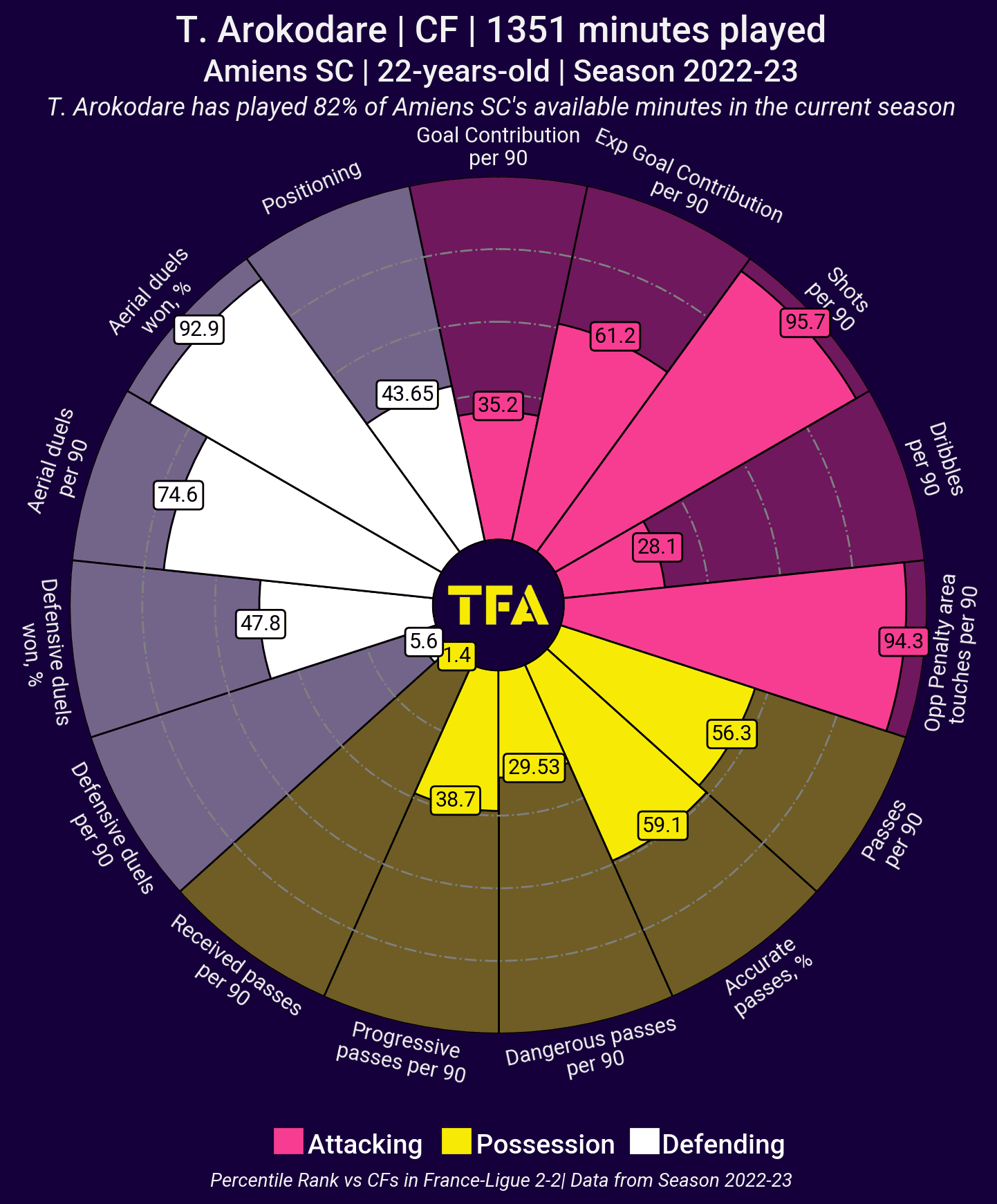
Offensively, the 22-year-old is a high-volume shot taker, as his high percentile ranking in shots per 90 from figure 1 shows. Arokodare’s taken 3.15 shots per 90 in Ligue 2 this season — the most of any centre-forward with at least 600 minutes of league football under their belt in 2022/23. He takes lots of touches inside the opposition’s penalty box and boasts decent xG contribution numbers while he doesn’t dribble very much.
Arokodare’s xG contribution numbers are primarily a result of his xG, as opposed to his xA. He’s got the highest xG of any striker in Ligue 2 (9.49) along with the best xG per 90 of any striker with at least 600 minutes in the league (0.59). Meanwhile, he’s got an xA of just 0.68, which is below average, and a low 0.04 xA per 90.
The Amiens attacker isn’t heavily involved in attacking build-up play but does make a respectable number of passes per 90 with fairly average passing accuracy. However, don’t expect to see Arokodare setting up many goalscoring chances — he makes few dangerous passes or even forward passes and, again, his xA numbers are quite low; he’s not in the team to be a playmaker.
Aerially, Arokodare is involved more than any other Amiens player, engaging in 7.97 aerial duels per 90 this term — the most of any Amiens player — while boasting an impressive 51.94% aerial duel success rate. It won’t come as a huge surprise, given the forward’s imposing height, that his team looks to use this natural gift as an offensive weapon, making Arokodare a key outlet for long balls at times.
Defensively, the Nigerian forward doesn’t contribute a great deal, as his low percentile ranking for defensive duels and uninspiring percentile ranking for defensive positioning indicate, and his output in this area is a clear weakness that others in the team must compensate for.
Offensive movement and positioning
A key reason for Arokodare’s potency in front of goal is his offensive off-the-ball movement and positioning. His ability to find space in valuable goalscoring areas and make good, well-timed runs in behind to give his deeper-lying teammates an attractive forward passing option have made him a very valuable asset up front for Amiens. This section of our analysis focuses on these areas of Arokodare’s game, highlighting some important points about his movement and positioning.
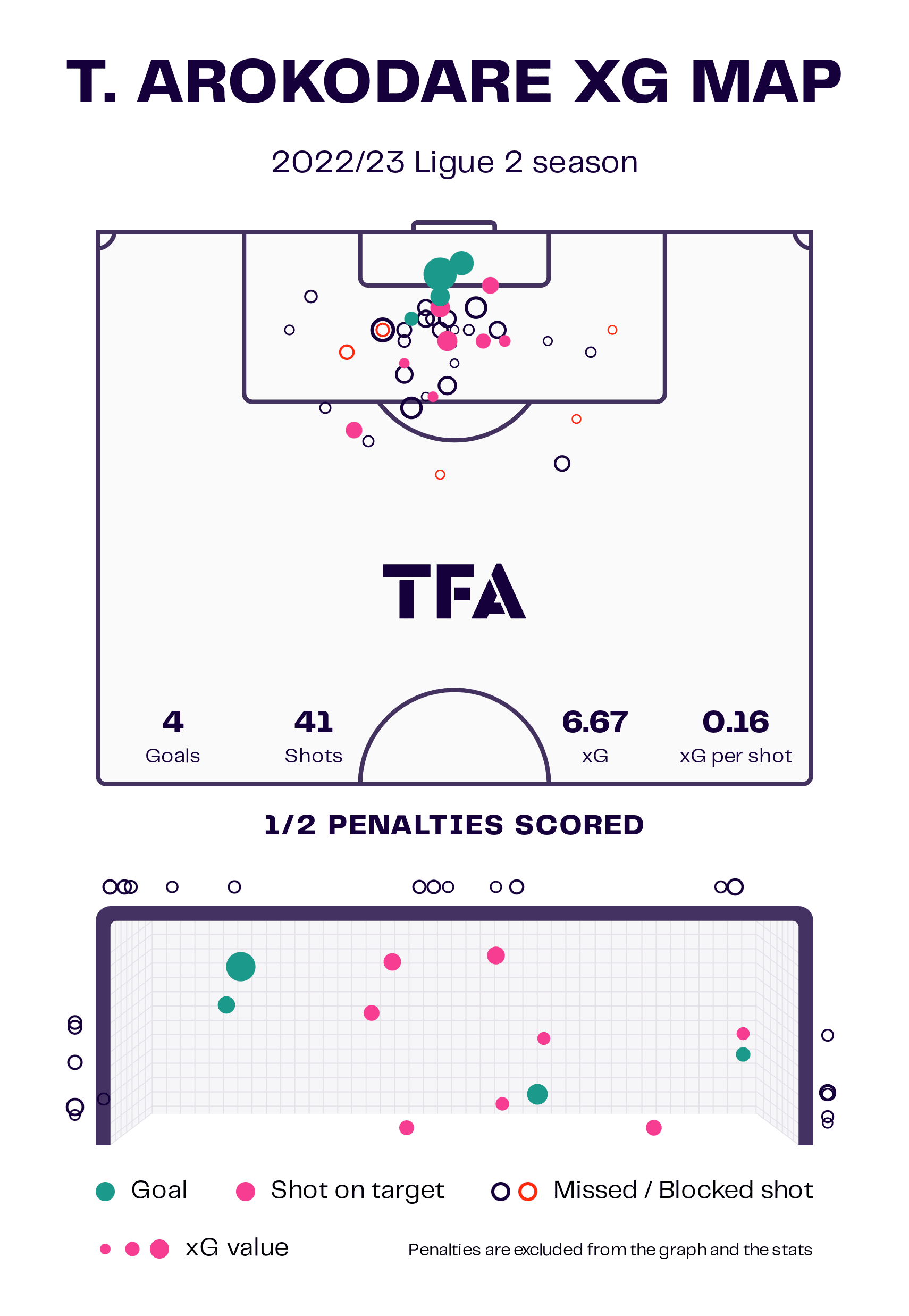
Starting with figure 2, here we can see Arokodare’s xG map from 2022/23 and in general, the map paints a very positive picture with regard to the player’s shot selection and positioning. He’s primarily taking shots from valuable central areas close to goal, and he’s maintaining a very nice 0.16 xG per shot.
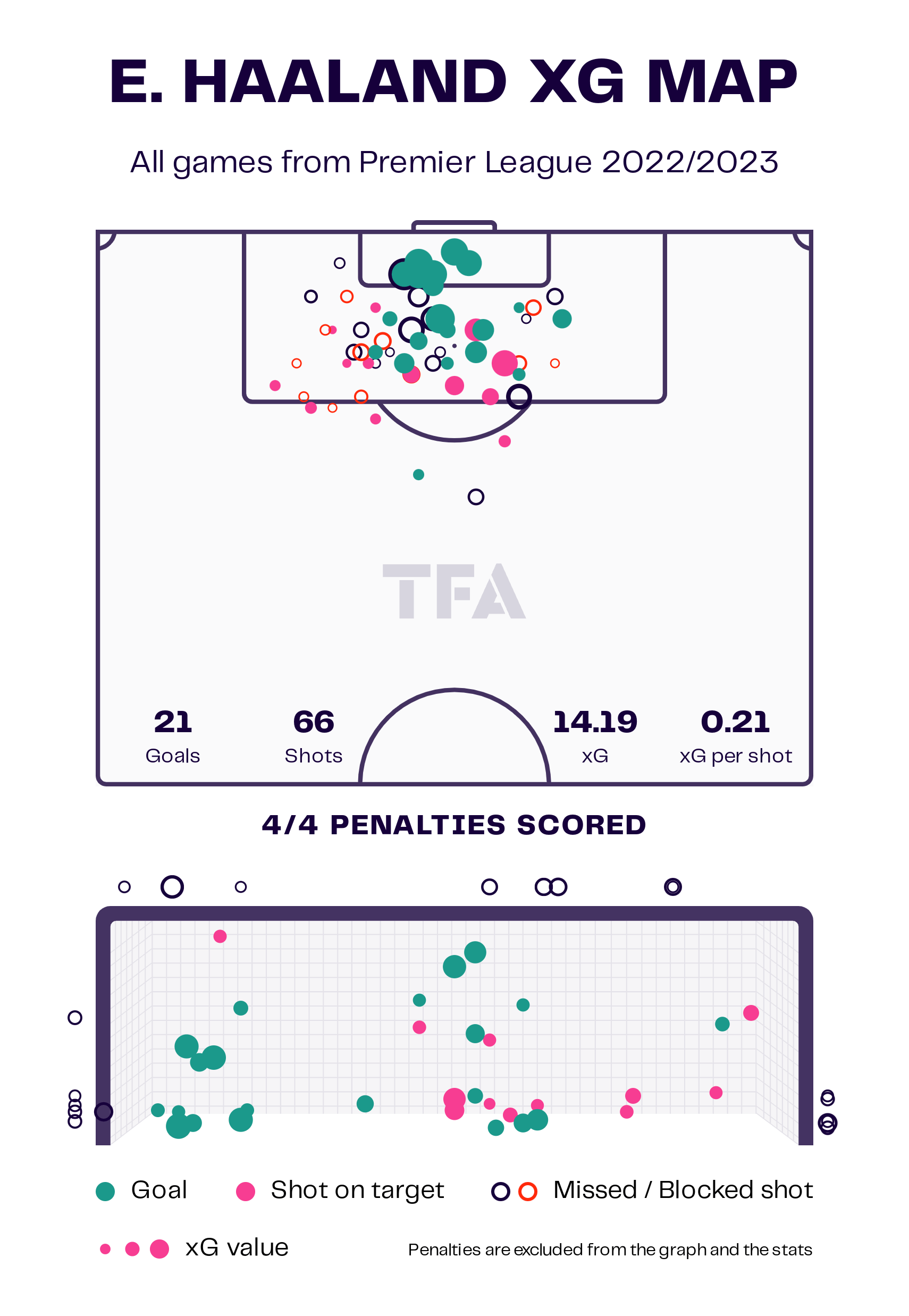
It’s not quite his guide Haaland’s xG map which boasts an 0.21 xG per shot, but it’s still impressive and we can understand that Arokodare is making a clear effort to emulate the Man City man to some degree, as he himself has explained, with regard to his positioning and shot selection.
His shot selection isn’t perfect. Still, he sometimes wastefully shoots while off-balance, leading to the ball flying well wide of the net, and still, he sometimes shoots from awkward positions of low value. If he receives with his back to goal, he often likes to shoot while turning towards goal and that generally doesn’t work out, again, with balance often proving a big issue there.
So, there are some obvious kinks to iron out within his shooting game but in general, he’s well aware of what good shooting positions and tends to occupy them and get shots off from those areas more often than not.
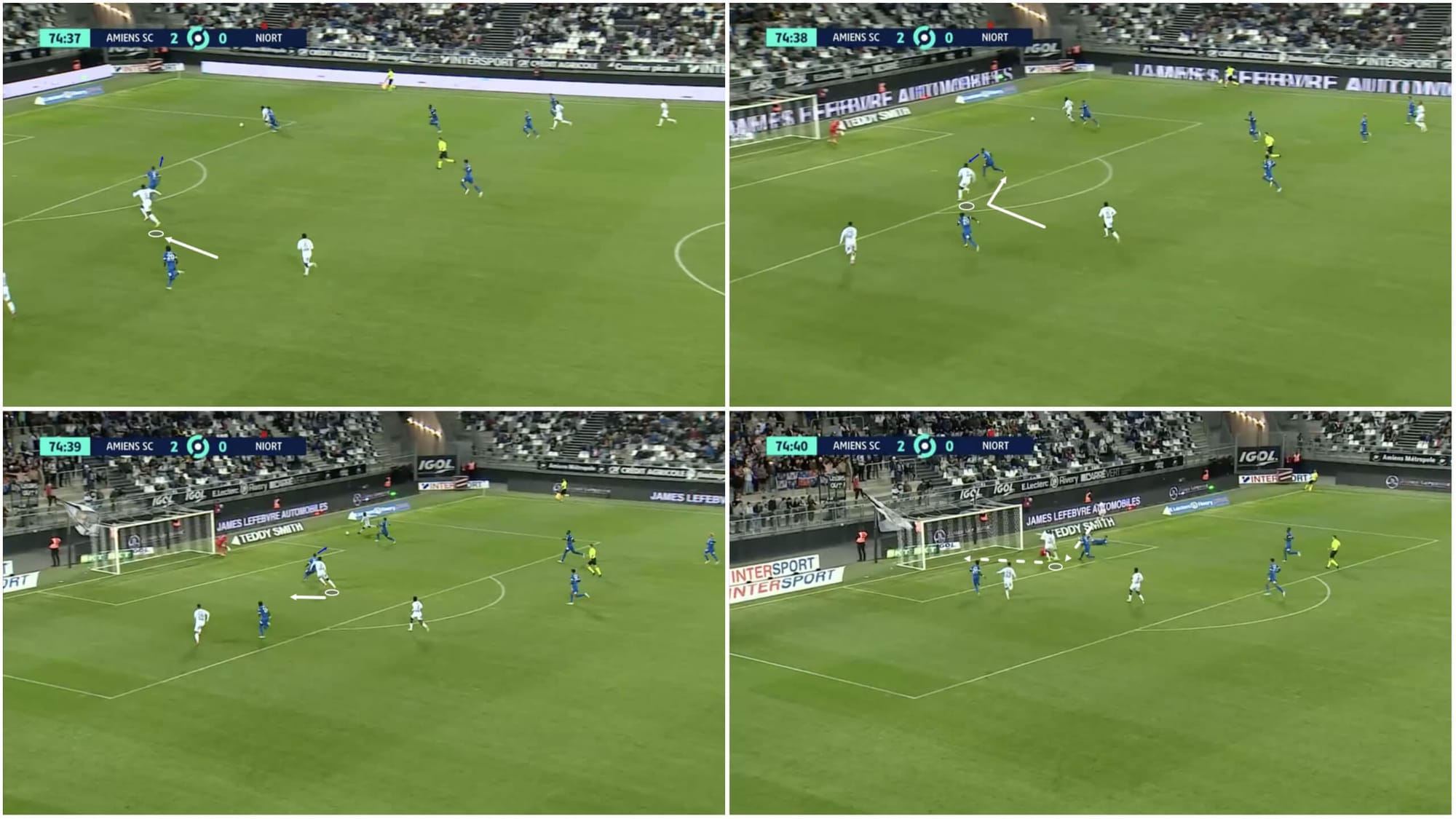
So, how does Arokodare find space in valuable goalscoring positions so much? We can see one example in figure 4. His movement here is excellent. Firstly, in the top-left quadrant, we see Arokodare targeting space behind the nearest defender while making a blindside run.
As the defender turns his head to check his shoulder and track the Amiens man’s run (top-right), Arokodare changes direction and seemingly begins targeting space in front of the defender. This creates confusion for the defender and causes him to second-guess his own positioning and as he turns back to face the ball carrier, he’s caught in two minds about where exactly he needs to direct his run and position himself.
Arokodare switches direction once more at this point, again targeting space on the defender’s blind side and this is where he eventually receives the ball in a great goalscoring position, where all he needs to do is gently stroke the ball in the direction of the goal and allow the force from his teammate’s low driven cross to do the work for him in the power department.
We see Arokodare intelligently adjust his running direction, focus and positioning a few different times in this example, providing an example of how varying up the direction of the movement and keeping the defender guessing are important parts of the attacker’s offensive game that help him to get on the ball in highly valuable shooting positions.
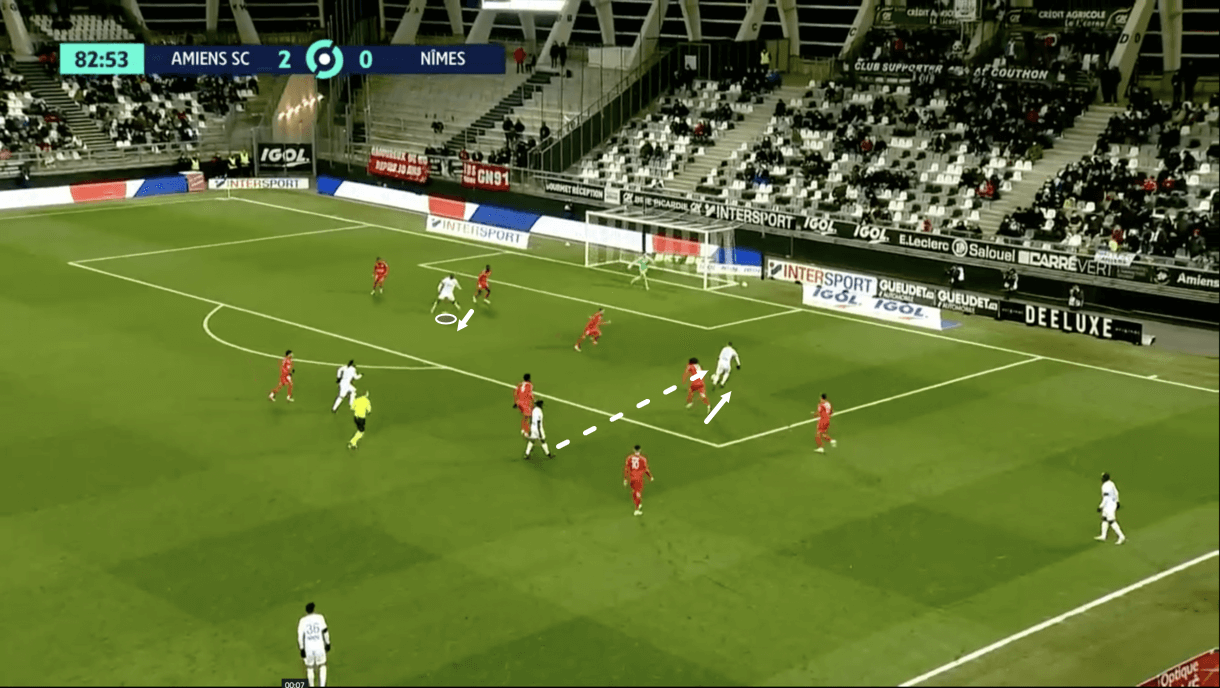
Separation from the nearest defender is important for Arokodare when his team is in the chance creation phase. Figure 5 shows Arokodare pulling back out away from goal slightly towards the edge of the box as his team gets in behind the opposition’s backline, naturally forcing their defenders to move closer to their goal, in order to quickly create that separation in a valuable position.
This type of ‘against the grain’ movement where Arokodare goes in the opposite direction of everyone else just a little bit to create an extra couple of inches of space between him and the defender is typical within his game and is a key element of his attacking approach to creating good, high-quality goalscoring opportunities.
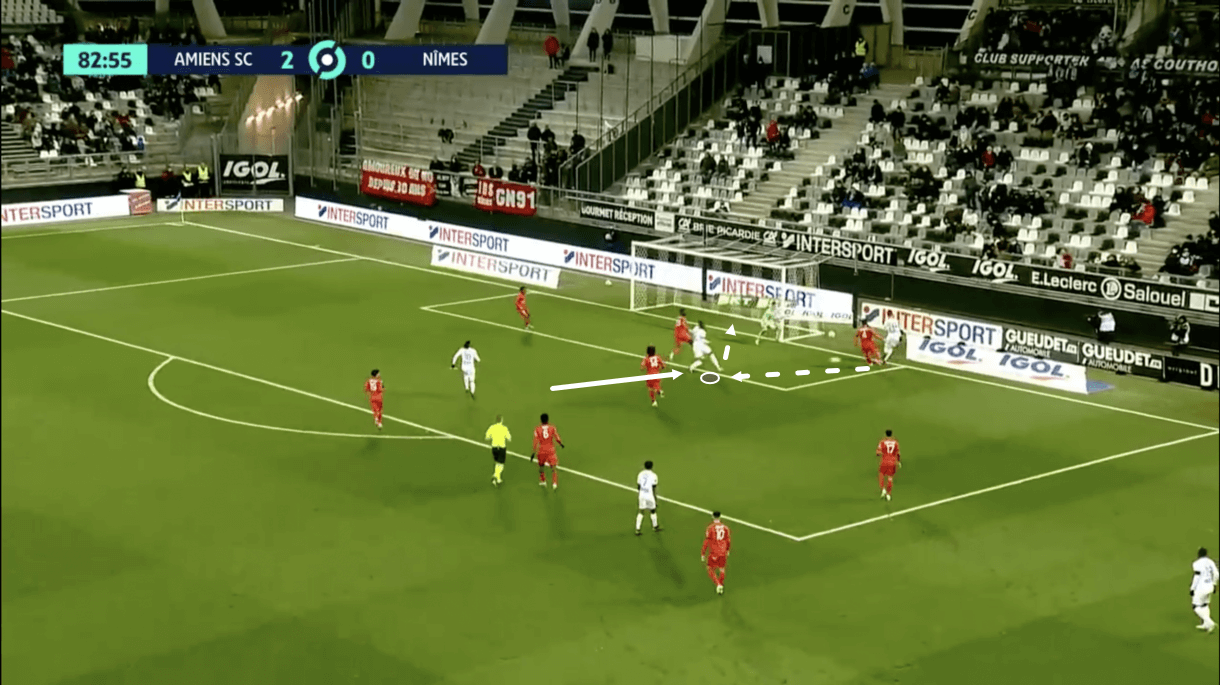
In figure 6, we see that Arokodare ends up bending a run around that defender towards the near post as play moves on, helping him to get a shot off from very close to goal — a great opportunity for Amiens.
His initial backwards movement against the tide of the rest of the players in this area created the necessary initial separation that gave the forward time and space to bend this run towards the front post and make himself an attractive passing option in a high-value position.
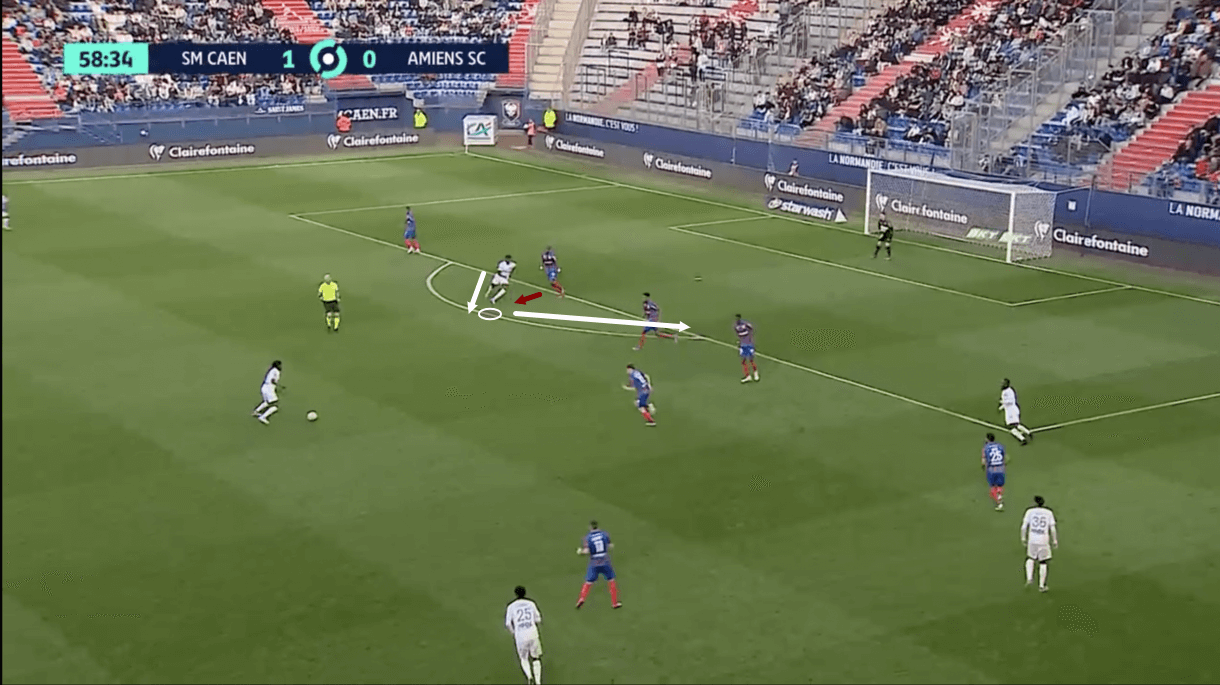
Arokodare possesses deceptive quickness, partly thanks to his long legs and lengthy running stride, and solid ability to exploit space behind the opposition’s backline, giving his team a good option should they wish to play a ball in behind. The player’s intelligent movement helps in this regard as well, as figures 7-8 will show.
Starting with figure 7, with Amiens in possession centrally, Arokodare initially pulls back towards midfield, faking as if he were looking for the ball to feet and, in the process, pulling the nearest opposition centre-back out with him a tad. As the opposition centre-back makes that step out, Arokodare changes direction, quickly darting in behind diagonally — a very tricky movement for the opposition defence to track as he passes from one player’s zone to another while accelerating into space.
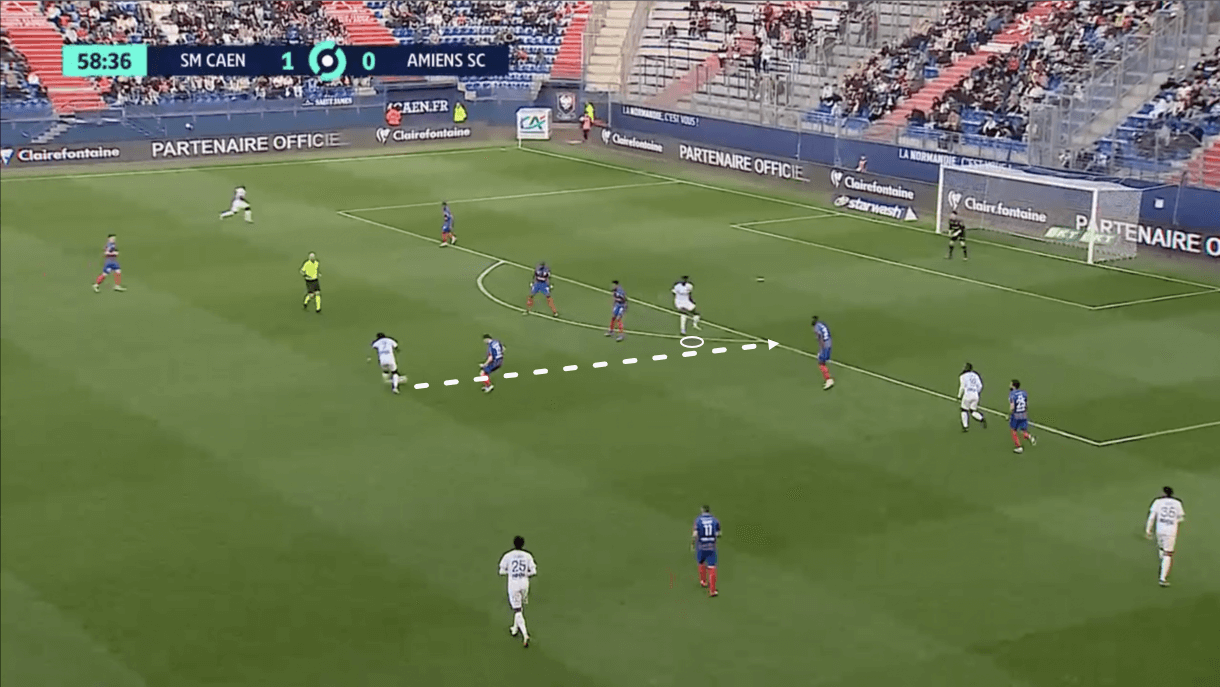
The ball didn’t come exactly when Arokodare might have wanted it, but it didn’t matter as the player halted his run, ensuring he remained onside, creating an extra couple of seconds for the midfielder to play the through ball in behind for the 22-year-old attacker to chase down.
Arokodare wouldn’t be the most confident dribbler in the world and if defenders manage to recover and get back behind the ball, the forward may opt to just shoot from distance rather than try to take them on, which can be wasteful. But he’s quite good at preventing those scenarios from happening and getting himself in clear space, whether that’s through movement in the box to create separation and find room in valuable positions for his teammates to cut the ball back to him or whether that’s while looking to exploit space behind the opposition’s backline.
Amiens have played far more crosses this season (17.3 per 90) than they did last season (11.39 per 90) and Arokodare has thrived in this. Firstly, at 197cm, his aerial threat is obvious and so high crosses can be lethal. However, as we’ve seen in this section, thanks to his positioning and movement, Arokodare’s also well capable of capitalising on low cutback crosses into valuable goalscoring positions, which he’s taken advantage of on numerous occasions this term.
As well as a variety of movements, Arokodare has a variety of finishing types in his locker. In general, he’s quite a calm and composed finisher who likes to stroke the ball home with placement over power but the 22-year-old can put plenty of force on the ball if he wants to. He’s shown a good ability to finish with the inside of his boot and the outside of his boot, as well as with both feet this season. So, he is resourceful when necessary in terms of getting the job done in front of goal.
With that said, Arokodare’s shot accuracy rate (33.33% this season) should be better given the positions he generally takes shots from, though this may improve with time. Over the last calendar year, his shot accuracy sits at 40.23% which is obviously an improvement on the 33.33% for just this season, though still not highly impressive. His conversion rate is also nothing to write home about and certainly represents an obvious area of improvement.
Linking up with midfield and drifting into wider areas
Our next section of analysis moves on to looking at Arokodare’s game from the perspective of link-up play with the midfield and involvement — outside of the finishing touches — in chance creation.
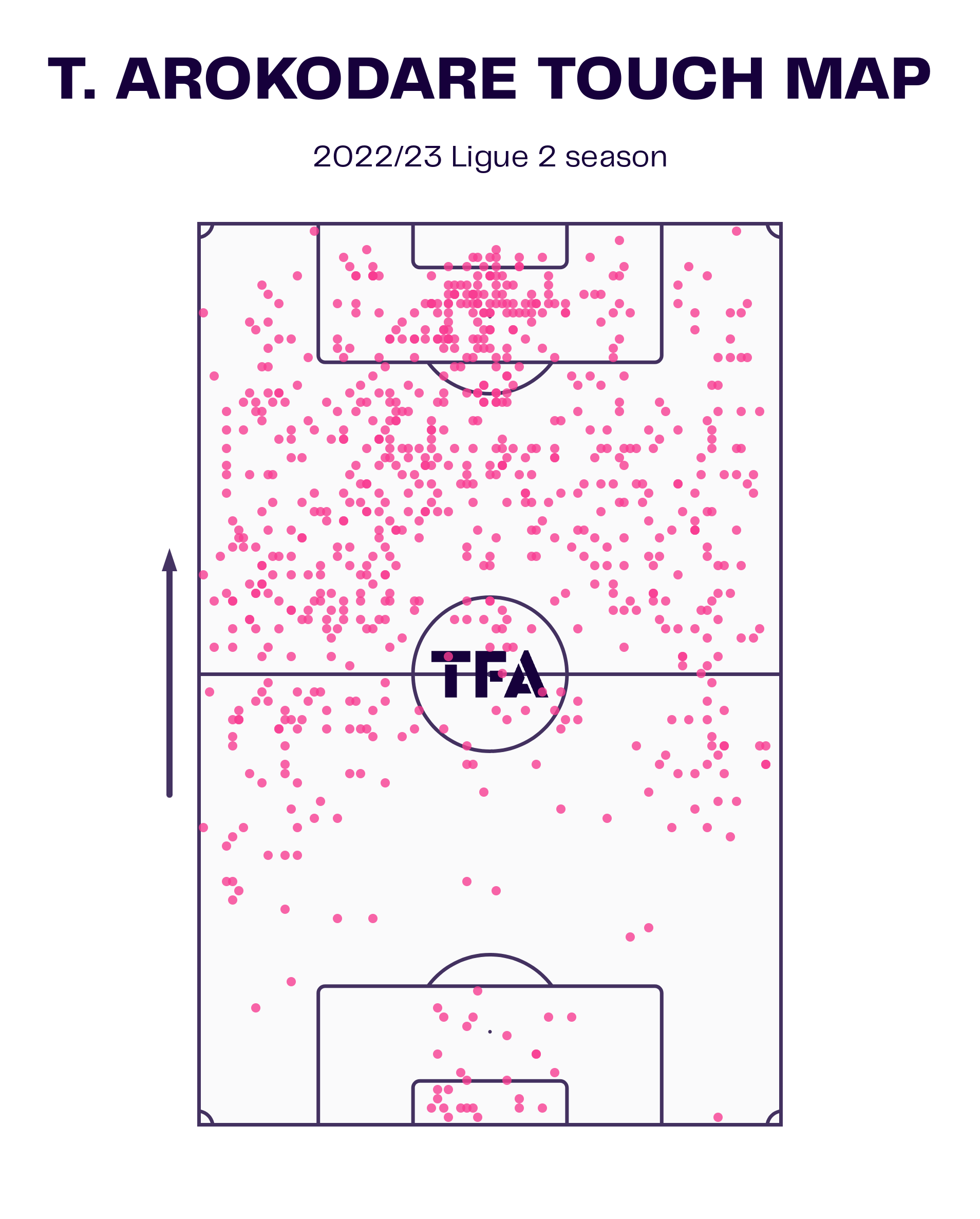
Most of the 22-year-old’s touches come from central positions inside the box; this is his most active area. However, Arokodare isn’t just found in these advanced central areas and may be seen in possession out in wider areas or even dropping deep to receive the ball to feet. His touch map from 2022/23 shown in figure 9 displays this.
Indeed, Arokodare likes to sometimes pull out into wider areas and perhaps try to carry the ball inside or may even end up shooting from a wider position — again, a result of some poor shot selection and lack of desire to take a defender on 1v1 with dribbling.
For us, it’d be best to avoid these wide areas where he doesn’t generally offer a lot and focus on staying centrally, finding space and picking up good positions there. Focus on the excellent off-the-ball work you can offer in chance creation and let others take care of the on-the-ball stuff. He can’t pass to himself and capitalise on his own off-the-ball movement when pulling into the wide areas to get involved in chance creation on the ball, and he simply offers much more off-the-ball in these scenarios.
The Nigerian forward is quite okay at recognising opportunities to drop off into space, make himself a short passing option and link up with deeper players successfully to help keep the attack moving smoothly.
At times, he can be prone to a too-heavy touch which makes his link-up play a bit unreliable, while his passing isn’t always the crispest and could do with some refinement. However, his movement is still top and this helps him to be somewhat of an asset if needed to drop off and receive to feet, though he’s definitely not at his best in such situations and, again, I’d limit instances of him dropping to receive to feet — he’s best receiving while facing forward.
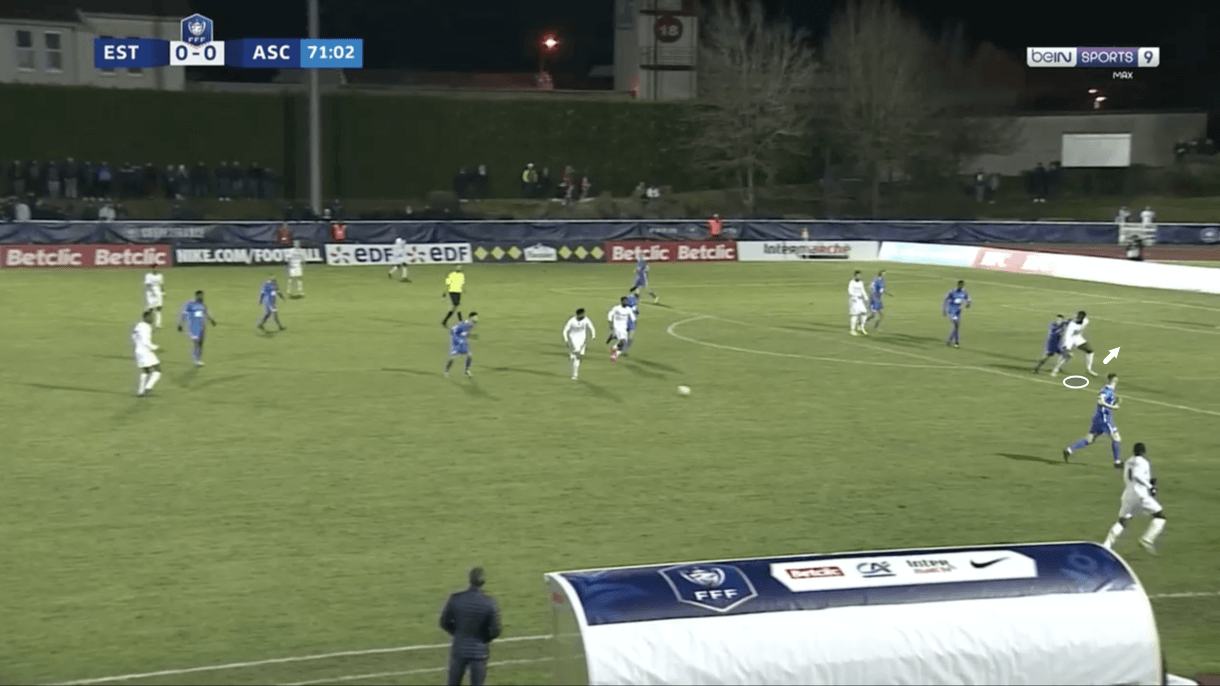
We see an example of Arokodare using his body movements to create space for himself when receiving to feet in figures 10-11. Firstly, in figure 10, we see Arokodare throwing his left shoulder back and feinting as if he were planning to turn around over his left shoulder on receiving the ball here.
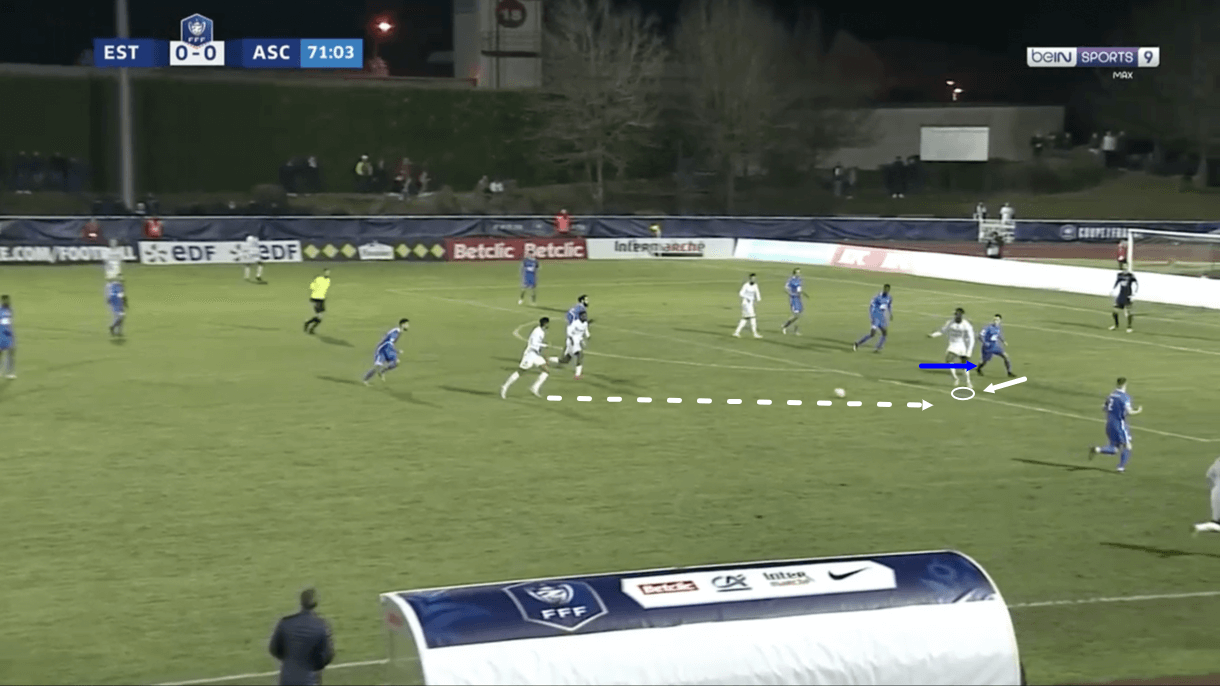
However, this intelligent movement simply served to fool the defender, who darted back to cover this potential reception on the half-turn in a dangerous position, allowing Arokodare to turn back towards the ball and receive with much more time and space than he otherwise would have, helping him to make his next move under less pressure.
So, while his technical quality isn’t always perfect, he’s great at using his footballing brain, which especially manifests itself via his positioning and movement, to help his team out and make him useful as a reference point for the attack where necessary — again, it’s not where he’s at his best at all but he has found some solutions for certain issues in this area of his game.
In terms of using his size, Arokodare is frequently targeted with long balls by Amiens. Aerially, he has a good leap on top of his size and is good at using his body to beat opponents to the ball and win aerial duels for his team. However, Amiens could probably set up better to win the second balls resulting from these aerial duels to make Arokodare’s contribution in this area a more wholly beneficial one.
Additionally, Arokodare has demonstrated impressive chest control, which is a unique but valuable skill for a forward that can help his team gain territory and get up the pitch quickly.
The 22-year-old loves to try a chest control/bicycle kick combo, but that is generally quite wasteful and not the best option on the table. The Amiens man should, perhaps, get his head up and look to lay it off to teammates a bit more from these situations.
Defensive contribution
Our final section of analysis focuses on Arokodare’s defensive contribution. As mentioned earlier, this isn’t a strength of the Nigerian forward’s game and is something his team must work together to compensate for.
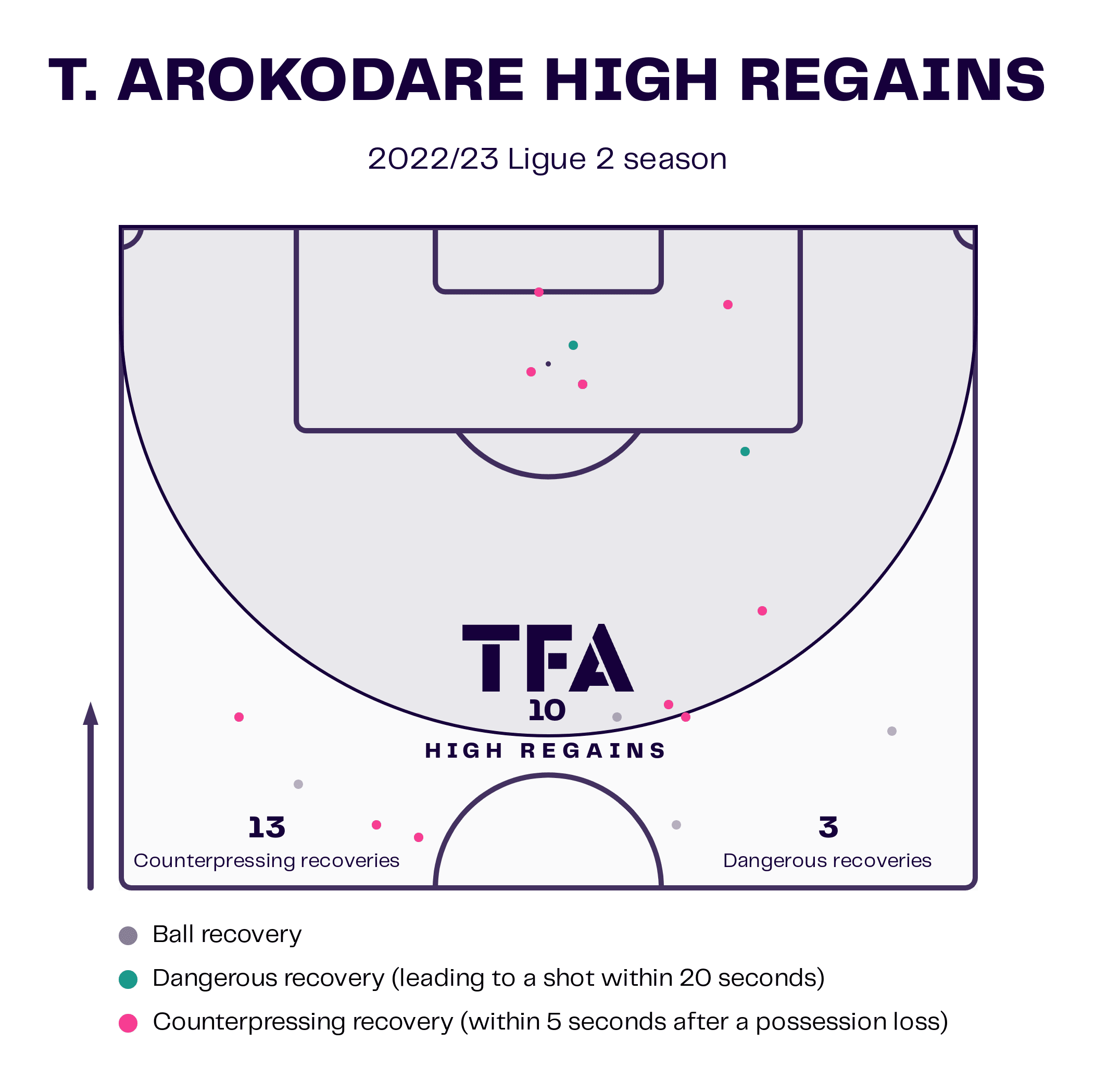
Arokodare’s high regains map from 2022/23 isn’t amazing, further highlighting his lack of major contribution in this area. Sure, he’s got 13 counterpressing recoveries this season, but you’d be looking for much more going on here after 19 league games to call this a strength for the 22-year-old.
He can be a bit slow to accelerate from a standing position in the high-block phase and when opponents progress beyond him and he looks to track back and recover, he can end up committing a foul very easily and clumsily.
In fact, Arokodare has made 1.61 fouls per 90 this season, which is relatively high among Ligue 2 centre-forwards. This is despite engaging in just 1.73 defensive duels per 90 this term — a very low number among Ligue 2 centre-forwards.
There have been a few different reasons resulting in this high number of fouls, and we’d say a lot of it could be chalked down to impatience and just carelessness at worst/clumsiness at best.
For instance, Arokodare may take a heavy touch when receiving to feet, look to recover and then leave a foot in too long or just not get there quickly enough. Of course, he can regain possession as a result of this too, but as his defensive numbers show, that’s not the norm.
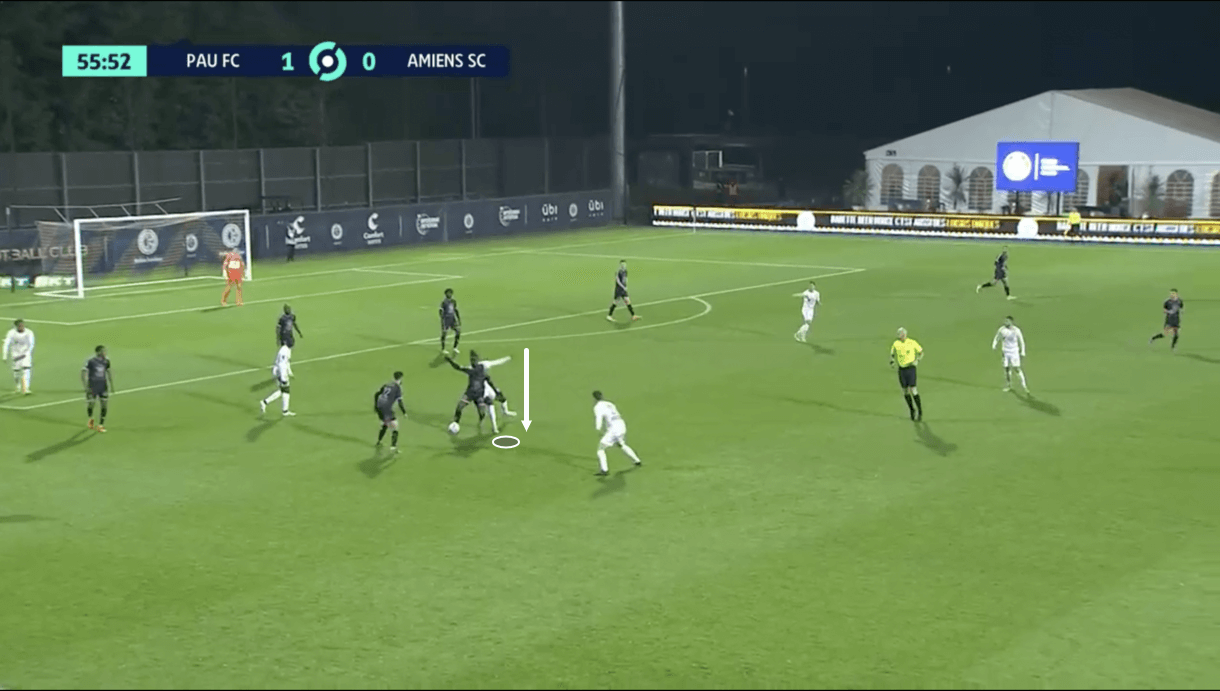
The 22-year-old can be a tad wreckless at times, for example in figure 13, we see him driving a shoulder into the opposition ball carrier’s back, forcing him to the ground and giving away a cheap free kick (though it did buy Amiens some time to get back into a settled shape!). We see this type of error in aerial duels at times as well, so Arokodare could be a bit more careful about throwing his body around and work on his defensive technique to improve this area of his game.
Conclusion
To conclude this tactical analysis and scout report, we feel Arokodare will certainly prove to be a bargain if Amiens sign him for the reported summer buy option fee based on what he’s shown in Ligue 2. He’s a fairly reliable goalscorer capable of finding space and picking up great positions in high-value parts of the pitch to give his team good goalscoring opportunities.
With that said, he can take his game up another couple of notches by refining his shot selection and technique on the ball, as well as his defensive technique. Mentally and physically, though, he is an impressive centre-forward to watch, and his varied finishing techniques are also solid for a Ligue 2 centre-forward.

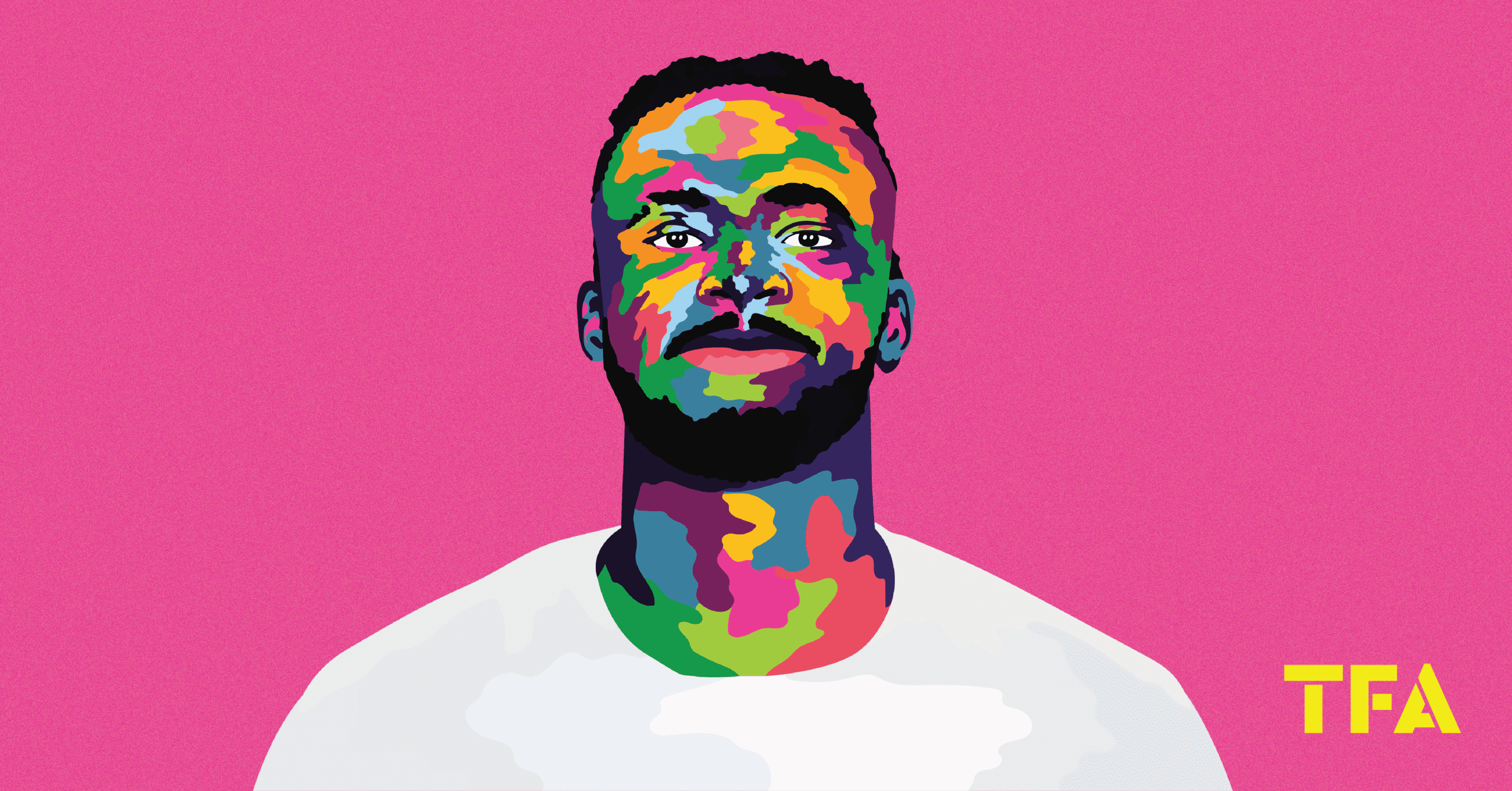



Comments